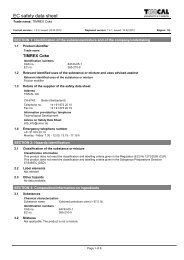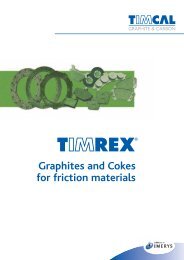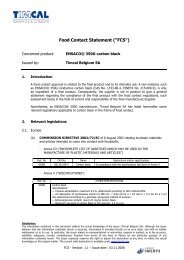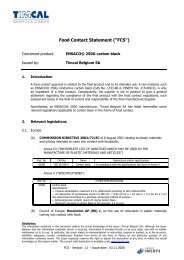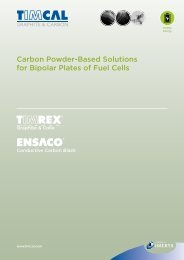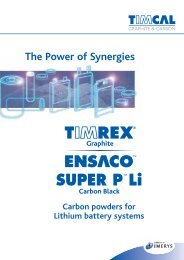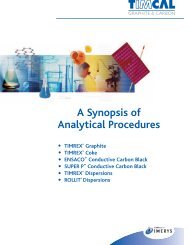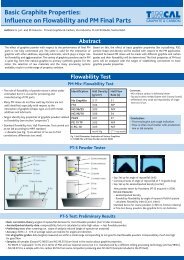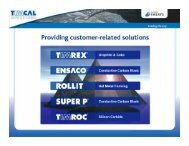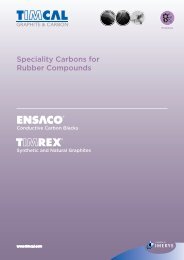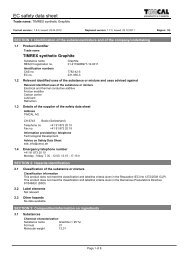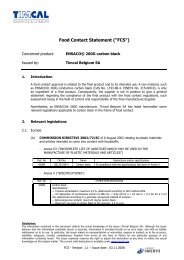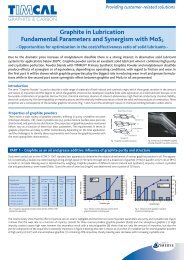Brochure: Carbon Additives for Polymer Compounds - Timcal Graphite
Brochure: Carbon Additives for Polymer Compounds - Timcal Graphite
Brochure: Carbon Additives for Polymer Compounds - Timcal Graphite
Create successful ePaper yourself
Turn your PDF publications into a flip-book with our unique Google optimized e-Paper software.
TYpICAL AppLICATIonS FoR TIMREX® GRApHITE And CokE<br />
18<br />
Self lubricating<br />
polymers<br />
The choice of a polymer-based self lubricating<br />
solid <strong>for</strong> a particular application depends mainly<br />
upon the operating conditions of: temperature,<br />
chemical environment and the maximum values<br />
of pressure (p) and sliding speed (v). For each<br />
polymer or composite material, a pv limit is quoted,<br />
which corresponds to the pressure times the<br />
sliding speed at which the material fails, either<br />
due to unacceptable de<strong>for</strong>mation, or to the high<br />
frictional energy dissipated causes surface melting,<br />
softening and excessive wear.<br />
The pv limit of a polymeric material may be increased<br />
by increasing its mechanical strength<br />
(resistance to de<strong>for</strong>mation), thermal conductivity<br />
(reduction in surface temperatures)<br />
and by decreasing friction (reduces frictional<br />
heating). In practice, thermoplastics (with the<br />
exception of PTFE) are mainly used as pure<br />
solids, since their wear resistance and frictional<br />
coefficient, are satisfactory <strong>for</strong> most applications.<br />
Solid lubricant fillers or fibre rein<strong>for</strong>cement<br />
(glass fibres, carbon fibres, textiles) are<br />
only employed under the more extreme conditions<br />
of load and speed.<br />
The major polymers employed as self lubricating<br />
solids/composites, are illustrated below.<br />
<strong>Graphite</strong> powder is widely used in polymer<br />
composites, either alone or in combination with<br />
rein<strong>for</strong>cing fibres, PTFE or various inorganic<br />
fillers, e.g. mica, talc (bottom, right table). Applications<br />
include gears, dry sliding bearings,<br />
seals, automotive and micro-mechanical parts.<br />
The properties of graphite which favour its use<br />
in polymer composites are:<br />
• low friction lamellar solid<br />
(reduces friction);<br />
• tendency to <strong>for</strong>m a transfer film on the<br />
countersurface<br />
(assists in wear reduction, particularly when<br />
graphite is applied as water based dispersion<br />
i.e. LB 1300);<br />
• high thermal conductivity<br />
(decreases temperature rise due to frictional<br />
heating);<br />
• electrical conductivity<br />
(prevent build-up of static charge which may<br />
be a problem in some cases);<br />
• chemically inert<br />
(used in conjunction with PTFE in corrosive<br />
environments);<br />
• high thermal stability<br />
(favours use in high temperature applications,<br />
e.g. polyimide graphite composites<br />
may be used up to 350°C).



